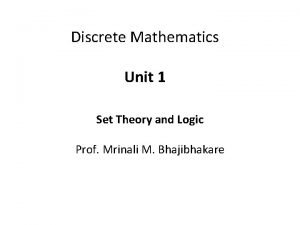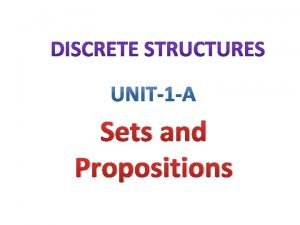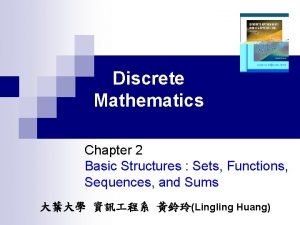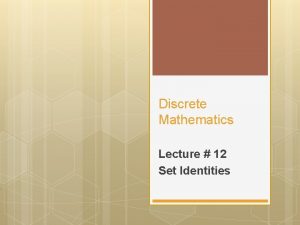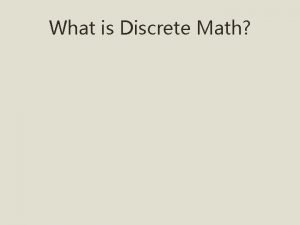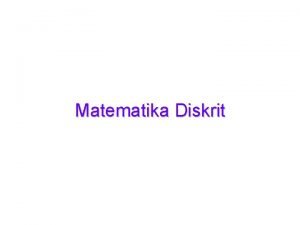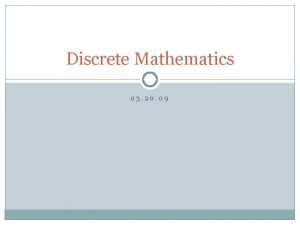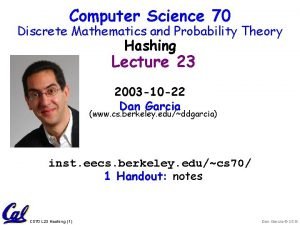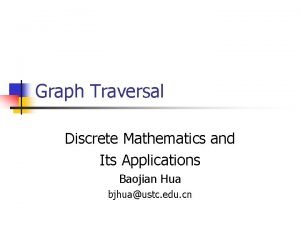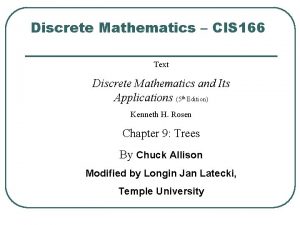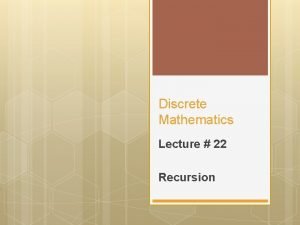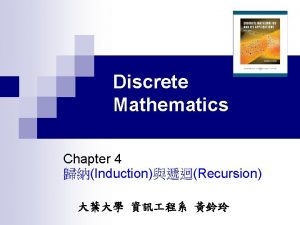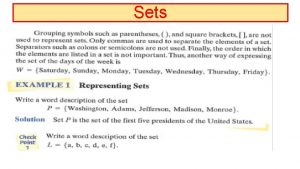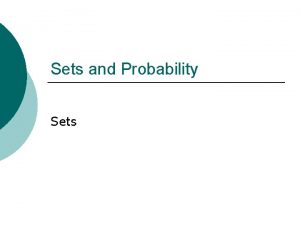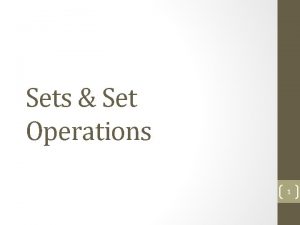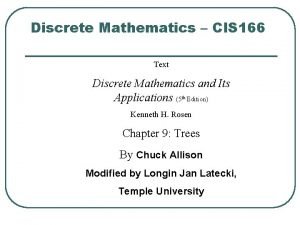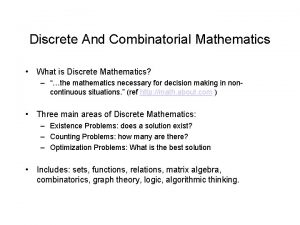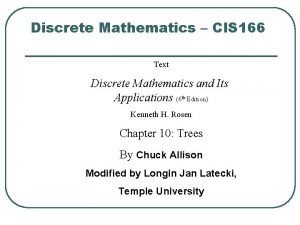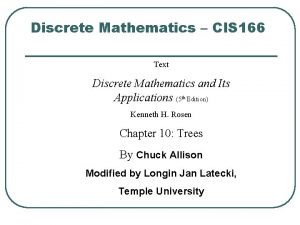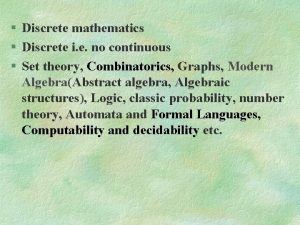Discrete Mathematics Set Sets Set a collection of














- Slides: 14

Discrete Mathematics Set

Sets Set = a collection of distinct unordered objects p Members of a set are called elements p How to determine a set p n Listing: p n Example: A = {1, 3, 5, 7} Description p Example: B = {x | x = 2 k + 1, 0 < k < 3}

Finite and infinite sets p Finite sets n Examples: A = {1, 2, 3, 4} q B = {x | x is an integer, 1 < x < 4} q q Infinite sets q Examples: Z = {integers} = {…, -3, -2, -1, 0, 1, 2, 3, …} q S={x| x is a real number and 1 < x < 4} = [0, 4] q

Some important sets The empty set has no elements. Also called null set or void set. q Universal set: the set of all elements about which we make assertions. q Examples: p n n n U = {all natural numbers} U = {all real numbers} U = {x| x is a natural number and 1< x<10}

Cardinality of a set A (in symbols |A|) is the number of elements in A p Examples: p If A = {1, 2, 3} then |A| = 3 If B = {x | x is a natural number and 1< x< 9} then |B| = 9 p Infinite cardinality n n Countable (e. g. , natural numbers, integers) Uncountable (e. g. , real numbers)

Subsets p X is a subset of Y if every element of X is also contained in Y (in symbols X Y) q Equality: X = Y if X Y and Y X p X is a proper subset of Y if X Y but Y X n Observation: is a subset of every set

Power set p The power set of X is the set of all subsets of X, in symbols P(X), n n q i. e. P(X)= {A | A X} Example: if X = {1, 2, 3}, then P(X) = { , {1}, {2}, {3}, {1, 2}, {1, 3}, {2, 3}, {1, 2, 3}} If |X| = n, then |P(X)| = 2 n.

Set operations: Union and Intersection Given two sets X and Y p The union of X and Y is defined as the set X Y = { x | x X or x Y} q The intersection of X and Y is defined as the set X Y = { x | x X and x Y} Two sets X and Y are disjoint if X Y =

Complement and Difference p The difference of two sets X – Y = { x | x X and x Y} The difference is also called the relative complement of Y in X Symmetric difference X Δ Y = (X – Y) (Y – X) q The complement of a set A contained in a universal set U is the set Ac = U – A q In symbols Ac = U - A

Venn diagrams A Venn diagram provides a graphic view of sets p Set union, intersection, difference, symmetric difference and complements can be identified p

Properties of set operations (1) Theorem 2. 1. 10: Let U be a universal set, and A, B and C subsets of U. The following properties hold: a) Associativity: (A B) C = A (B C) (A B) C = A (B C) b) Commutativity: A B = B A A B=B A

Properties of set operations (2) c) Distributive laws: A (B C) = (A B) (A C) d) Identity laws: A U=A A = A e) Complement laws: A Ac = U A Ac =

Properties of set operations (3) f) Idempotent laws: A A = A g) Bound laws: A U = U h) Absorption laws: A (A B) = A A A = A A = A (A B) = A

Properties of set operations (4) i) Involution law: (Ac)c = A j) 0/1 laws: c = U Uc = k) De Morgan’s laws for sets: (A B)c = Ac Bc
 What is discrete math
What is discrete math Sets and propositions in discrete mathematics
Sets and propositions in discrete mathematics Sets and functions in discrete mathematics
Sets and functions in discrete mathematics Set identities in discrete mathematics
Set identities in discrete mathematics Discrete mathematics
Discrete mathematics Matematika diskrit kenneth rosen pdf
Matematika diskrit kenneth rosen pdf Homogeneous recurrence relation
Homogeneous recurrence relation Basics of counting in discrete mathematics
Basics of counting in discrete mathematics Division algorithm in discrete mathematics
Division algorithm in discrete mathematics Discrete mathematics uses
Discrete mathematics uses Probability theory in discrete mathematics
Probability theory in discrete mathematics Dfs in discrete mathematics
Dfs in discrete mathematics M ary tree in discrete mathematics
M ary tree in discrete mathematics Recursive definition of odd positive integers
Recursive definition of odd positive integers Discrete mathematics chapter 1
Discrete mathematics chapter 1
